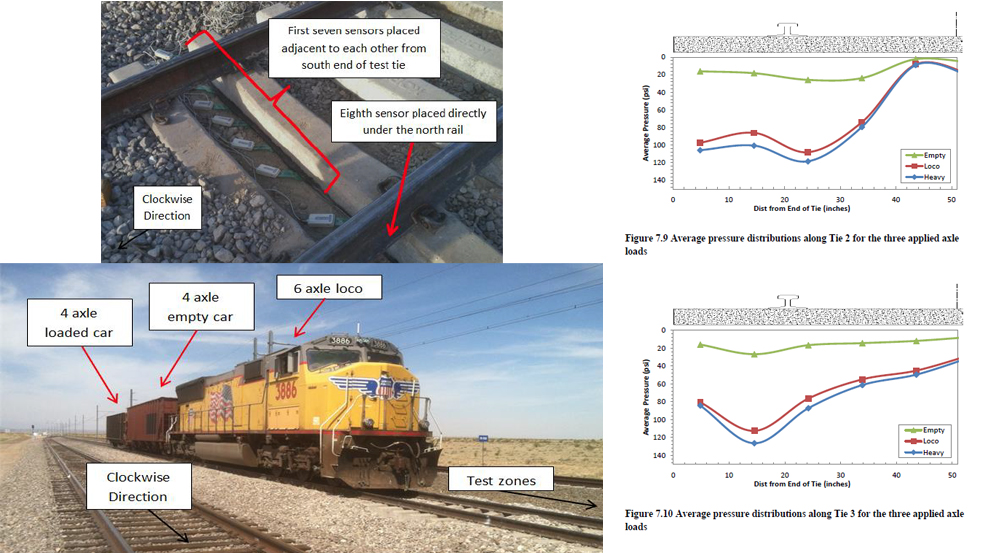Innovating Ballast-Tie Testing Procedures for Railroad Track Designs
While the engineering world is abuzz with ideas for driverless cars and smart vehicles, railroads are still important to the lifeblood of many regions around the world. However, despite being one of the oldest forms of mass transportation, railroads are being held to modern standards to deliver more while maintaining efficiency.
To meet these growing demands, trains today are being sent out with heavier axle loads, forcing the railroad industry to reevaluate existing infrastructure to accommodate increased traffic volume. Utilizing non-intrusive testing methods to measure pressure at different levels and interfaces on a railroad track structure can help engineers improve track designs for greater longevity.
A New, Effective Method to Test the Ballast-Tie Interface
Figure 1: A conceptual comparison between average pressure distribution and actual pressure distribution of the ballast-tie interface. The red dashes represent the actual pressure distribution. (Source: McHenry, M.)Track ballasts are used to bear the load of the railroad ties. They usually consist of crushed stones and other rugged materials. Track ballasts also provide several other functions to the railroad track, such as aiding in water drainage, and restricting the growth of plants that may interfere with the track structure.
Recently, researchers at the University of Kentucky’s Department of Civil Engineering began exploring new methods to measure the ballast-tie interface of a railroad track. They employed Tekscan pressure mapping technology to measure the actual pressure distribution at the ballast-tie interface.
The ballast-tie interface is characterized by high pressures as a result of low effective contact areas between the tie and the individual ballast particles that make up the contact surface. Figure 1 displays a cross section of the portion of the ballast directly beneath the tie.
Using I-Scan pressure mapping technology, the researchers tested true pressure distribution at the ballast-tie interface, including:
- Distribution of pressure along the length of the tie
- Distribution of pressure across the width of the tie
- Distribution of pressure over time under dynamic loading conditions
In-Track Testing Process and Results
 Figure 2: Above shows the location of I-Scan sensors on each test tie during the in-track testing. A locomotive with two four-axle cars (one loaded, one unloaded) was used in the tests. The graphs on the right illustrate data captured from one of the five testing zones. (Source: McHenry, M.)
Figure 2: Above shows the location of I-Scan sensors on each test tie during the in-track testing. A locomotive with two four-axle cars (one loaded, one unloaded) was used in the tests. The graphs on the right illustrate data captured from one of the five testing zones. (Source: McHenry, M.)
The researchers prepared a railroad track with five different testing zones, each with their own unique ballast material. Each zone consisted of three railroad ties, two of which had pressure mapping sensors placed below the tie and against the ballast material. Two four-axle railroad cars connected to a six-axle locomotive (71,825 lbs) were used in this experiment. One car was loaded with material (79,425 lbs), while a similar car was unloaded (16,688 lbs).
Two train passes were run on each zone – one pass driving forward, and another driving in reverse. The train speed varied between five and 10 mph. In total, 46 individual tests were performed across the five different zones.
The pressure distributions along the length of 10 test ties demonstrated variability that could be seen even within the same type of track and adjacent ties. The results show the realization of the areal and temporal pressure distribution between the ballast tie, and thus provide a new way to test real-time pressure on track components.
Interested in reading the complete thesis? Click here to access the report.
Source: McHenry, Michael T., "PRESSURE MEASUREMENT AT THE BALLAST-TIE INTERFACE OF RAILROAD TRACK USING MATRIX BASED TACTILE SURFACE SENSORS" (2013). University of Kentucky, Theses and Dissertations--Civil Engineering. 15.
